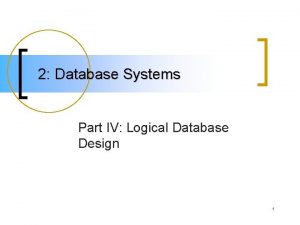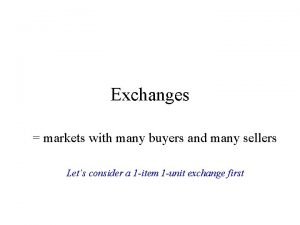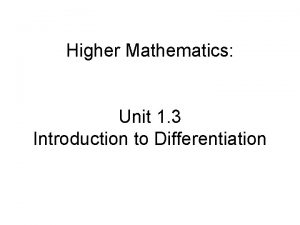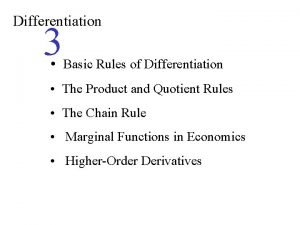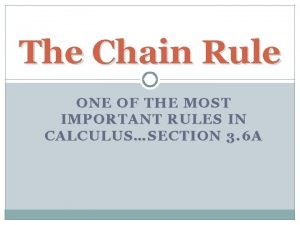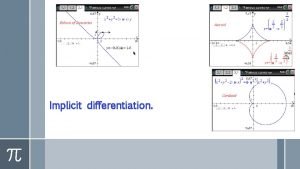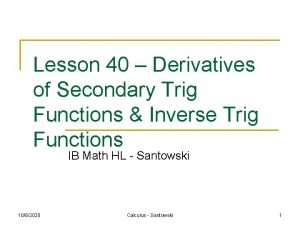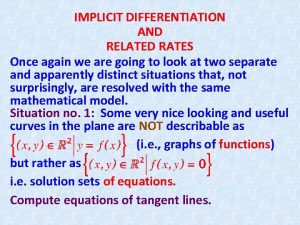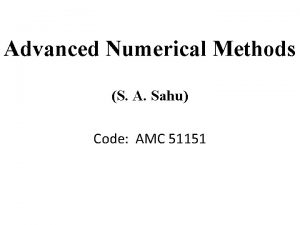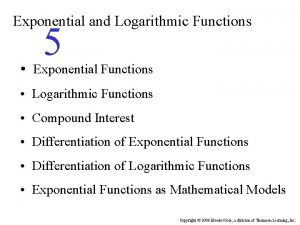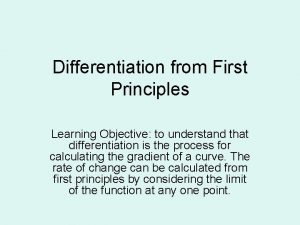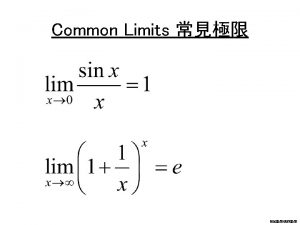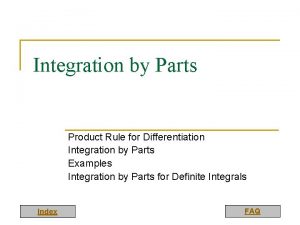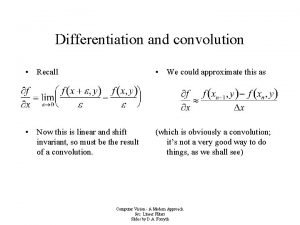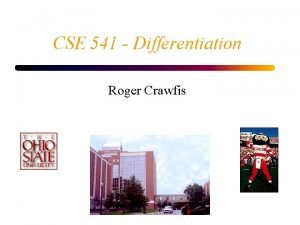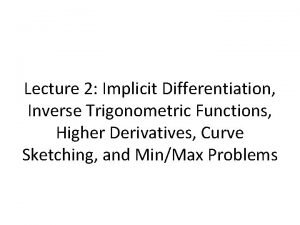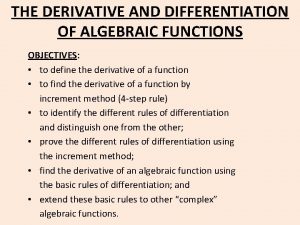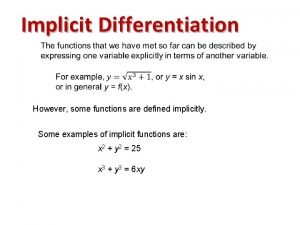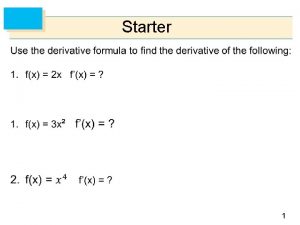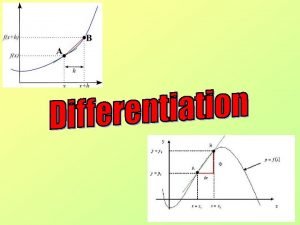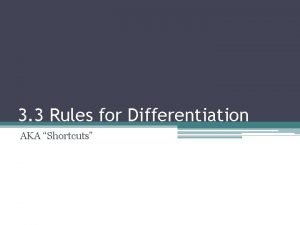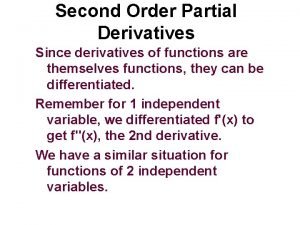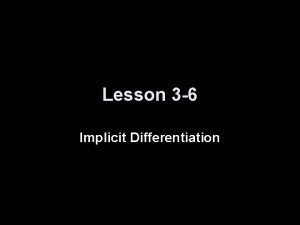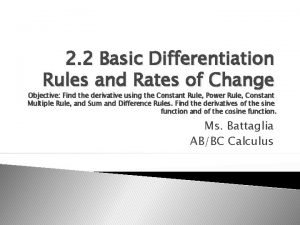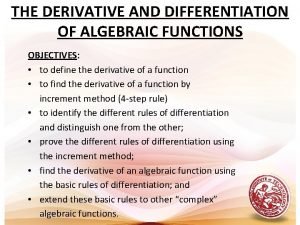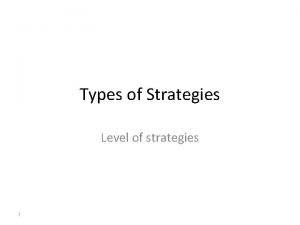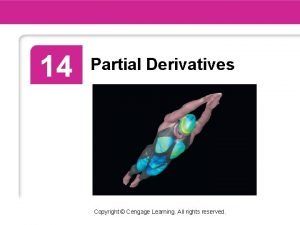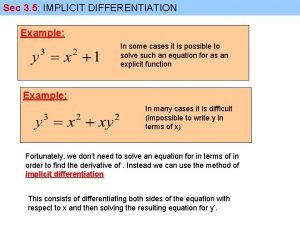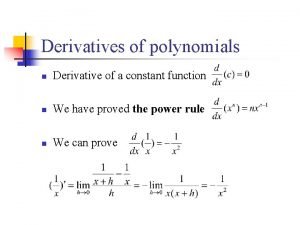4 APPLICATIONS OF DIFFERENTIATION APPLICATIONS OF DIFFERENTIATION Many





























































































- Slides: 93

4 APPLICATIONS OF DIFFERENTIATION

APPLICATIONS OF DIFFERENTIATION Many applications of calculus depend on our ability to deduce facts about a function f from information concerning its derivatives.

APPLICATIONS OF DIFFERENTIATION 4. 3 How Derivatives Affect the Shape of a Graph In this section, we will learn: How the derivative of a function gives us the direction in which the curve proceeds at each point.

DERIVATIVES AND GRAPH SHAPE As f’(x) represents the slope of the curve y = f(x) at the point (x, f(x)), it tells us the direction in which the curve proceeds at each point. § Thus, it is reasonable to expect that information about f’(x) will provide us with information about f(x).

WHAT DOES f’ SAY ABOUT f ? To see how the derivative of f can tell us where a function is increasing or decreasing, look at the figure. § Increasing functions and decreasing functions were defined in Section 1. 1

WHAT DOES f’ SAY ABOUT f ? Between A and B and between C and D, the tangent lines have positive slope. So, f’(x) > 0.

WHAT DOES f’ SAY ABOUT f ? Between B and C, the tangent lines have negative slope. So, f’(x) < 0.

WHAT DOES f’ SAY ABOUT f ? Thus, it appears that f increases when f’(x) is positive and decreases when f’(x) is negative. § To prove that this is always the case, we use the Mean Value Theorem.

INCREASING/DECREASING TEST (I/D TEST) a. If f’(x) > 0 on an interval, then f is increasing on that interval. b. If f’(x) < 0 on an interval, then f is decreasing on that interval.

I/D TEST Proof a Let x 1 and x 2 be any two numbers in the interval with x 1 < x 2. According to the definition of an increasing function, we have to show that f(x 1) < f(x 2).

I/D TEST Proof a (Equation 1) Since we are given that f’(x) > 0, we know that f is differentiable on [x 1, x 2]. So, by the Mean Value Theorem, there is a number c between x 1 and x 2 such that: f(x 2) – f(x 1) = f’(c)(x 2 – x 1)

I/D TEST Proof a and b Now, f’(c) > 0 by assumption and x 2 – x 1 > 0 because x 1 < x 2. Thus, the right side of Equation 1 is positive. So, f(x 2) – f(x 1) > 0 or f(x 1) < f(x 2) § This shows that f is increasing. § Part (b) is proved similarly.

I/D TEST Example 1 Find where the function f(x) = 3 x 4 – 4 x 3 – 12 x 2 + 5 is increasing and where it is decreasing.

I/D TEST Example 1 f’(x) = 12 x 3 - 12 x 2 - 24 x = 12 x(x – 2)(x + 1) § To use the ID Test, we have to know where f’(x) > 0 and where f’(x) < 0. § This depends on the signs of the three factors of f’(x)—namely, 12 x, x – 2, and x + 1.

I/D TEST Example 1 We divide the real line into intervals whose endpoints are the critical numbers -1, 0, and 2 and arrange our work in a chart.

I/D TEST Example 1 A plus sign indicates the given expression is positive. A minus sign indicates it is negative. The last column gives the conclusion based on the I/D Test.

I/D TEST Example 1 For instance, f’(x) < 0 for 0 < x < 2. So, f is decreasing on (0, 2). § It would also be true to say that f is decreasing on the closed interval.

I/D TEST The graph of f confirms the information in the chart. Example 1

WHAT DOES f’ SAY ABOUT f ? Recall from Section 4. 1 that, if f has a local maximum or minimum at c, then c must be a critical number of f (by Fermat’s Theorem). § However, not every critical number gives rise to a maximum or a minimum. § So, we need a test that will tell us whether or not f has a local maximum or minimum at a critical number.

WHAT DOES f’ SAY ABOUT f ? You can see from the figure that f(0) = 5 is a local maximum value of f because f increases on (-1, 0) and decreases on (0, 2). § In terms of derivatives, f’(x) > 0 for -1 < x < 0 and f’(x) < 0 for 0 < x < 2.

WHAT DOES f’ SAY ABOUT f ? In other words, the sign of f’(x) changes from positive to negative at 0. § This observation is the basis of the following test.

FIRST DERIVATIVE TEST Suppose that c is a critical number of a continuous function f. a. If f’ changes from positive to negative at c, then f has a local maximum at c.

FIRST DERIVATIVE TEST b. If f’ changes from negative to positive at c, then f has a local minimum at c.

FIRST DERIVATIVE TEST c. If f’ does not change sign at c—for example, if f’ is positive on both sides of c or negative on both sides—then f has no local maximum or minimum at c.

FIRST DERIVATIVE TEST The First Derivative Test is a consequence of the I/D Test. § For instance, in (a), since the sign of f’(x) changes from positive to negative at c, f is increasing to the left of c and decreasing to the right of c. § It follows that f has a local maximum at c.

FIRST DERIVATIVE TEST It is easy to remember the test by visualizing diagrams.

WHAT DOES f’ SAY ABOUT f ? Example 2 Find the local minimum and maximum values of the function f in Example 1.

WHAT DOES f’ SAY ABOUT f ? Example 2 From the chart in the solution to Example 1, we see that f’(x) changes from negative to positive at -1. § So, f(-1) = 0 is a local minimum value by the First Derivative Test.

WHAT DOES f’ SAY ABOUT f ? Example 2 Similarly, f’ changes from negative to positive at 2. § So, f(2) = -27 is also a local minimum value.

WHAT DOES f’ SAY ABOUT f ? Example 2 As previously noted, f(0) = 5 is a local maximum value because f’(x) changes from positive to negative at 0.

WHAT DOES f’ SAY ABOUT f ? Example 3 Find the local maximum and minimum values of the function g(x) = x + 2 sin x 0 ≤ x ≤ 2π

WHAT DOES f’ SAY ABOUT f ? Example 3 To find the critical numbers of g, we differentiate: g’(x) = 1 + 2 cos x § So, g’(x) = 0 when cos x = - ½. § The solutions of this equation are 2π/3 and 4π/3.

WHAT DOES f’ SAY ABOUT f ? Example 3 As g is differentiable everywhere, the only critical numbers are 2π/3 and 4π/3. So, we analyze g in the following table.

WHAT DOES f’ SAY ABOUT f ? Example 3 As g’(x) changes from positive to negative at 2π/3, the First Derivative Test tells us that there is a local maximum at 2π/3. § The local maximum value is:

WHAT DOES f’ SAY ABOUT f ? Example 3 Likewise, g’(x) changes from negative to positive at 4π/3. § So, a local minimum value is:

WHAT DOES f’ SAY ABOUT f ? Example 3 The graph of g supports our conclusion.

WHAT DOES f’’ SAY ABOUT f ? The figure shows the graphs of two increasing functions on (a, b).

WHAT DOES f’’ SAY ABOUT f ? Both graphs join point A to point B, but they look different because they bend in different directions. § How can we distinguish between these two types of behavior?

WHAT DOES f’’ SAY ABOUT f ? Here, tangents to these curves have been drawn at several points.

CONCAVE UPWARD In the first figure, the curve lies above the tangents and f is called concave upward on (a, b).

CONCAVE DOWNWARD In the second figure, the curve lies below the tangents and g is called concave downward on (a, b).

CONCAVITY—DEFINITION If the graph of f lies above all of its tangents on an interval I, it is called concave upward on I. If the graph of f lies below all of its tangents on I, it is called concave downward on I.

CONCAVITY The figure shows the graph of a function that is concave upward (CU) on the intervals (b, c), (d, e), and (e, p) and concave downward (CD) on the intervals (a, b), (c, d), and (p, q).

CONCAVITY Let’s see how the second derivative helps determine the intervals of concavity.

CONCAVITY From this figure, you can see that, going from left to right, the slope of the tangent increases. § This means that the derivative f’ is an increasing function and therefore its derivative f” is positive.

CONCAVITY Likewise, in this figure, the slope of the tangent decreases from left to right. So, f’ decreases and therefore f’’ is negative. § This reasoning can be reversed and suggests that the following theorem is true.

CONCAVITY TEST a. If f’’(x) > 0 for all x in I, then the graph of f is concave upward on I. b. If f’’(x) < 0 for all x in I, then the graph of f is concave downward on I.

CONCAVITY Example 4 The figure shows a population graph for Cyprian honeybees raised in an apiary. § How does the rate of population increase change over time? § When is this rate highest? § Over what intervals is P concave upward or concave downward?

CONCAVITY Example 4 By looking at the slope of the curve as t increases, we see that the rate of increase of the population is initially very small. § Then, it gets larger until it reaches a maximum at about t = 12 weeks, and decreases as the population begins to level off.

CONCAVITY Example 4 As the population approaches its maximum value of about 75, 000 (called the carrying capacity), the rate of increase, P’(t), approaches 0. § The curve appears to be concave upward on (0, 12) and concave downward on (12, 18).

INFLECTION POINT In the example, the curve changed from concave upward to concave downward at approximately the point (12, 38, 000). § This point is called an inflection point of the curve.

INFLECTION POINT The significance of this point is that the rate of population increase has its maximum value there. § In general, an inflection point is a point where a curve changes its direction of concavity.

INFLECTION POINT—DEFINITION A point P on a curve y = f(x) is called an inflection point if f is continuous there and the curve changes from concave upward to concave downward or from concave downward to concave upward at P.

INFLECTION POINT For instance, here, B, C, D, and P are the points of inflection. § Notice that, if a curve has a tangent at a point of inflection, then the curve crosses its tangent there.

INFLECTION POINT In view of the Concavity Test, there is a point of inflection at any point where the second derivative changes sign.

WHAT DOES f’’ SAY ABOUT f ? Example 5 Sketch a possible graph of a function f that satisfies the following conditions: (i) f’(x) > 0 on (-∞ , 1), f’(x) < 0 on (1, ∞) (ii) f’’(x) > 0 on (-∞, -2) and (2, ∞), f’’(x) < 0 on (-2, 2) (iii) ,

WHAT DOES f’’ SAY ABOUT f ? E. g. 5—Condition i The first condition tells us that f is increasing on (-∞ , 1) and decreasing on (1, ∞).

WHAT DOES f’’ SAY ABOUT f ? E. g. 5—Condition ii The secondition says that f is concave upward on (-∞, -2) and (2, ∞), and concave downward on (-2, 2).

WHAT DOES f’’ SAY ABOUT f ? E. g. 5—Condition iii From the third condition, we know that the graph of f has two horizontal asymptotes: § y = -2 §y=0

WHAT DOES f’’ SAY ABOUT f ? E. g. 5—Condition iii We first draw the horizontal asymptote y = -2 as a dashed line. § We then draw the graph of f approaching this asymptote at the far left—increasing to its maximum point at x = 1 and decreasing toward the x-axis at the far right.

WHAT DOES f’’ SAY ABOUT f ? E. g. 5—Condition iii We also make sure that the graph has inflection points when x = -2 and 2. § Notice that we made the curve bend upward for x < -2 and x > 2, and bend downward when x is between -2 and 2.

WHAT DOES f’’ SAY ABOUT f ? Another application of the second derivative is the following test for maximum and minimum values. § It is a consequence of the Concavity Test.

SECOND DERIVATIVE TEST Suppose f’’ is continuous near c. a. If f’(c) = 0 and f’’(c) > 0, then f has a local minimum at c. b. If f’(c) = 0 and f’’(c) < 0, then f has a local maximum at c.

SECOND DERIVATIVE TEST For instance, (a) is true because f’’(x) > 0 near c, and so f is concave upward near c. § This means that the graph of f lies above its horizontal tangent at c, and so f has a local minimum at c.

WHAT DOES f’’ SAY ABOUT f ? Example 6 Discuss the curve y = x 4 – 4 x 3 with respect to concavity, points of inflection, and local maxima and minima. Use this information to sketch the curve.

WHAT DOES f’’ SAY ABOUT f ? Example 6 If f(x) = x 4 – 4 x 3, then: f’(x) = 4 x 3 – 12 x 2 = 4 x 2(x – 3) f’’(x) = 12 x 2 – 24 x = 12 x(x – 2)

WHAT DOES f’’ SAY ABOUT f ? Example 6 To find the critical numbers, we set f’(x) = 0 and obtain x = 0 and x = 3. To use the Second Derivative Test, we evaluate f’’ at these critical numbers: f’’(0) = 0 f’’(3) = 36 > 0

WHAT DOES f’’ SAY ABOUT f ? Example 6 As f’(3) = 0 and f’’(3) > 0, f(3) = -27 is a local minimum. As f’’(0) = 0, the Second Derivative Test gives no information about the critical number 0.

WHAT DOES f’’ SAY ABOUT f ? Example 6 However, since f’(x) < 0 for x < 0 and also for 0 < x < 3, the First Derivative Test tells us that f does not have a local maximum or minimum at 0. § In fact, the expression for f’(x) shows that f decreases to the left of 3 and increases to the right of 3.

WHAT DOES f’’ SAY ABOUT f ? Example 6 As f’’(x) = 0 when x = 0 or 2, we divide the real line into intervals with those numbers as endpoints and complete the following chart.

WHAT DOES f’’ SAY ABOUT f ? Example 6 The point (0, 0) is an inflection point—since the curve changes from concave upward to concave downward there.

WHAT DOES f’’ SAY ABOUT f ? Example 6 Also, (2, -16) is an inflection point—since the curve changes from concave downward to concave upward there.

WHAT DOES f’’ SAY ABOUT f ? Example 6 Using the local minimum, the intervals of concavity, and the inflection points, we sketch the curve.

NOTE The Second Derivative Test is inconclusive when f’’(c) = 0. § In other words, at such a point, there might be a maximum, a minimum, or neither (as in the example).

NOTE The test also fails when f’’(c) does not exist. In such cases, the First Derivative Test must be used. § In fact, even when both tests apply, the First Derivative Test is often the easier one to use.

WHAT DOES f’’ SAY ABOUT f ? Example 7 Sketch the graph of the function f(x) = x 2/3(6 – x)1/3 § You can use the differentiation rules to check that the first two derivatives are: § As f’(x) = 0 when x = 4 and f’(x) does not exist when x = 0 or x = 6, the critical numbers are 0, 4, and 6.

WHAT DOES f’’ SAY ABOUT f ? Example 7 To find the local extreme values, we use the First Derivative Test. § As f’ changes from negative to positive at 0, f(0) = 0 is a local minimum.

WHAT DOES f’’ SAY ABOUT f ? Example 7 § Since f’ changes from positive to negative at 4, f(4) = 25/3 is a local maximum. § The sign of f’ does not change at 6, so there is no minimum or maximum there.

WHAT DOES f’’ SAY ABOUT f ? Example 7 The Second Derivative Test could be used at 4, but not at 0 or 6—since f’’ does not exist at either of these numbers.

WHAT DOES f’’ SAY ABOUT f ? Example 7 Looking at the expression for f’’(x) and noting that x 4/3 ≥ 0 for all x, we have: § f’’(x) < 0 for x < 0 and for 0 < x < 6 § f’’(x) > 0 for x > 6

WHAT DOES f’’ SAY ABOUT f ? Example 7 So, f is concave downward on (-∞, 0) and (0, 6) and concave upward on (6, ∞), and the only inflection point is (6, 0). § Note that the curve has vertical tangents at (0, 0) and (6, 0) because |f’(x)| → ∞ as x → 0 and as x → 6.

WHAT DOES f’’ SAY ABOUT f ? Example 8 Use the first and second derivatives of f(x) = e 1/x, together with asymptotes, to sketch its graph. § Notice that the domain of f is {x | x ≠ 0}. § So, we check for vertical asymptotes by computing the left and right limits as x → 0.

WHAT DOES f’’ SAY ABOUT f ? As x → 0+, we know that t = 1/x → ∞. So, § This shows that x = 0 is a vertical asymptote.

WHAT DOES f’’ SAY ABOUT f ? As x → 0 -, we know that t = 1/x → -∞. So,

WHAT DOES f’’ SAY ABOUT f ? As x → ±∞, we have 1/x → 0. So, § This shows that y = 1 is a horizontal asymptote.

WHAT DOES f’’ SAY ABOUT f ? Now, let’s compute the derivative. The Chain Rule gives: § Since e 1/x > 0 and x 2 > 0 for all x ≠ 0, we have f’(x) < 0 for all x ≠ 0. § Thus, f is decreasing on (-∞, 0) and on (0, ∞).

WHAT DOES f’’ SAY ABOUT f ? There is no critical number. So, the function has no maximum or minimum.

WHAT DOES f’’ SAY ABOUT f ? The second derivative is:

WHAT DOES f’’ SAY ABOUT f ? As e 1/x > 0 and x 4 > 0, we have: f’’(x) > 0 when x > -½ (x ≠ 0) f’’(x) < 0 when x < -½ § So, the curve is concave downward on (-∞, -½) and concave upward on (-½, 0) and on (0, ∞). § The inflection point is (-½, e-2).

WHAT DOES f’’ SAY ABOUT f ? To sketch the graph of f, we first draw the horizontal asymptote y = 1 (as a dashed line), together with the parts of the curve near the asymptotes in a preliminary sketch.

WHAT DOES f’’ SAY ABOUT f ? These parts reflect the information concerning limits and the fact that f is decreasing on both ( -∞, 0) and (0, ∞). § Notice that we have indicated that f(x) → 0 as x → 0 even though f(0) does not exist.

WHAT DOES f’’ SAY ABOUT f ? Here, we finish the sketch by incorporating the information concerning concavity and the inflection point.

WHAT DOES f’’ SAY ABOUT f ? Finally, we check our work with a graphing device.
 Unary relationship database
Unary relationship database Convert conceptual model to logical model
Convert conceptual model to logical model Unary many to many
Unary many to many Many sellers and many buyers
Many sellers and many buyers Erm vs erd
Erm vs erd Many-to-many communication
Many-to-many communication Many buyers and sellers
Many buyers and sellers Unary many to many
Unary many to many Sqlbi many to many
Sqlbi many to many Er diagram in dbms
Er diagram in dbms Erd film
Erd film Differentiation
Differentiation Scaffolding vs differentiation
Scaffolding vs differentiation Selecting an overall positioning strategy
Selecting an overall positioning strategy Differentiate actual self from ideal self
Differentiate actual self from ideal self T-tess student growth goals examples texas
T-tess student growth goals examples texas Differentiation of sin inverse x
Differentiation of sin inverse x Chain rule examples
Chain rule examples Stationary point of a function
Stationary point of a function Derivative of composite function
Derivative of composite function Blood physiology guyton
Blood physiology guyton Partial differentiation
Partial differentiation Explicit differentiation
Explicit differentiation Hyperbolic differentiation formulas
Hyperbolic differentiation formulas Ixj
Ixj Integral of inverse trig functions
Integral of inverse trig functions The pitfalls of a differentiation strategy include
The pitfalls of a differentiation strategy include Integrity vs despair
Integrity vs despair Delayed differentiation and modular design
Delayed differentiation and modular design Differentiation syndrome
Differentiation syndrome Differentiation vs specialization
Differentiation vs specialization Delayed differentiation and modular design
Delayed differentiation and modular design How jcpenney sailed into a red ocean
How jcpenney sailed into a red ocean Differentiation by outcome
Differentiation by outcome Implicit differentiation and related rates
Implicit differentiation and related rates Log function properties
Log function properties Derive gauss forward interpolation formula
Derive gauss forward interpolation formula Exponential function division
Exponential function division Quotient rule uv-vu/ v 2
Quotient rule uv-vu/ v 2 Diff from first principles
Diff from first principles Differentiation 數學
Differentiation 數學 High accuracy differentiation formulas
High accuracy differentiation formulas Hyperbolic differentiation formulas
Hyperbolic differentiation formulas Differentiation by parts
Differentiation by parts Segmentation targeting differentiation and positioning
Segmentation targeting differentiation and positioning Differentiation rules
Differentiation rules Reciprocal rule differentiation
Reciprocal rule differentiation Differentiation of convolution
Differentiation of convolution Chapter 5 the five generic competitive strategies
Chapter 5 the five generic competitive strategies Second partial derivative formula
Second partial derivative formula Nestle differentiation strategy
Nestle differentiation strategy What is the average speed
What is the average speed Numerical differentiation
Numerical differentiation Product differentiation
Product differentiation Implicit differentiation with inverse trig functions
Implicit differentiation with inverse trig functions Science differentiation in action
Science differentiation in action Differentiating content
Differentiating content Differentiation
Differentiation Functions defined implicitly
Functions defined implicitly Formula of differentiation
Formula of differentiation Automatic differentiation tutorial
Automatic differentiation tutorial Product formula of differentiation
Product formula of differentiation Diane m sullivan
Diane m sullivan Differentiate
Differentiate Constant multiple theorem
Constant multiple theorem Second order partial derivatives
Second order partial derivatives Diff of sec^2x
Diff of sec^2x Niche differentiation capsim
Niche differentiation capsim Differentiation of cosh2y
Differentiation of cosh2y Differentiation of t cell
Differentiation of t cell Orthogonal unit differentiation
Orthogonal unit differentiation Differentiation
Differentiation Ncca differentiation
Ncca differentiation Porters strategies
Porters strategies Dr frost differentiation
Dr frost differentiation Sin-1x formula
Sin-1x formula What are the basic rules of differentiation?
What are the basic rules of differentiation? What are pitfalls in differentiation
What are pitfalls in differentiation Partial total derivative
Partial total derivative Richardson extrapolation formula for differentiation
Richardson extrapolation formula for differentiation Shaping within topography example
Shaping within topography example How to differentiate algebraic functions
How to differentiate algebraic functions Adding new, unrelated products or services
Adding new, unrelated products or services Implicit differentiation formula
Implicit differentiation formula Fourier transform time shift
Fourier transform time shift Carpet patch differentiation
Carpet patch differentiation What is differentiation advantage
What is differentiation advantage Mnes pursuing a multidomestic strategy hope that
Mnes pursuing a multidomestic strategy hope that Intermediate variable
Intermediate variable 5 bases of differentiation
5 bases of differentiation How to do implicit differentiation
How to do implicit differentiation Differentiation business level strategy
Differentiation business level strategy Derivative of constant number
Derivative of constant number Differentiation product rule
Differentiation product rule


